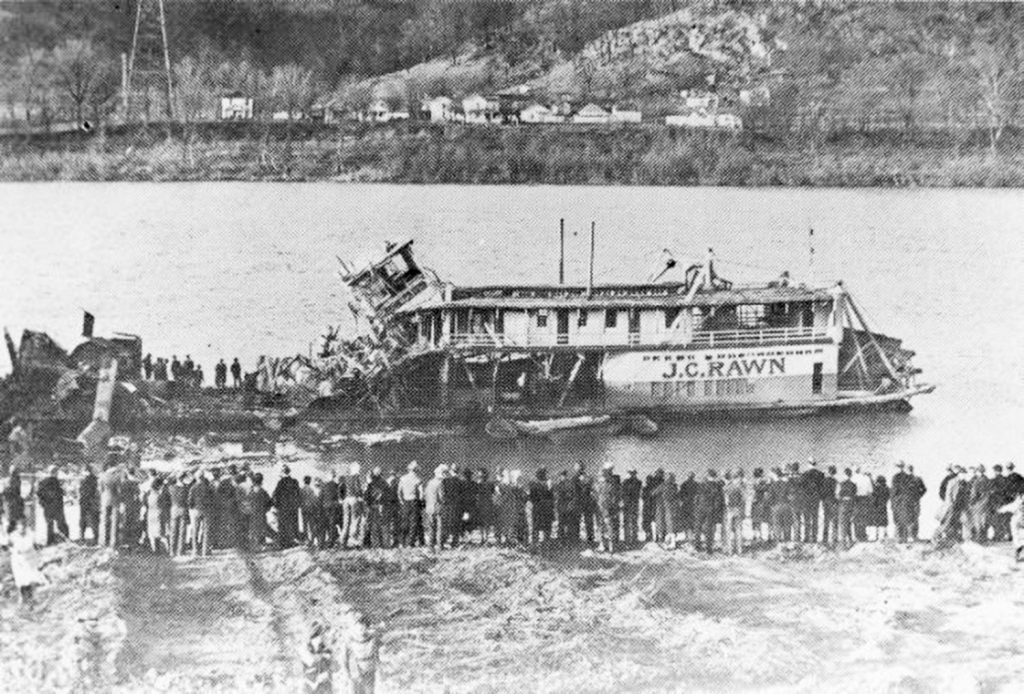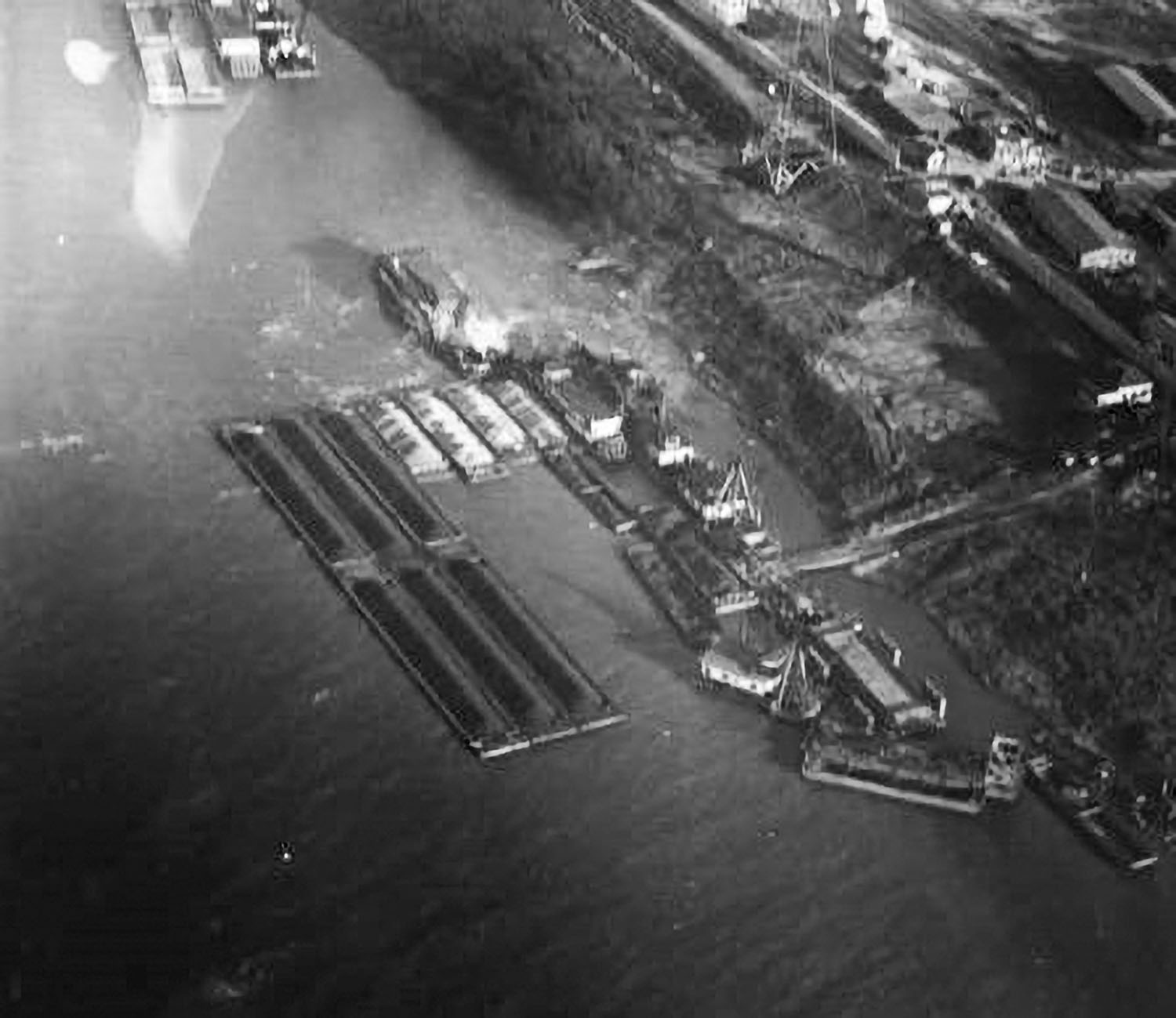In the last column we looked at the steamer J.C. Rawn (Way’s T1236), built by Howard in 1911 as the H.S. Chamberlain for the Roane Iron Company and operated on the Tennessee River.
The sternwheeler originally had a wooden hull that was 140 by 30 feet and engines that were 16’s, 6-foot stroke. In 1926, the wood hull was replaced with a new steel hull that was 135.5 by 30 feet. In 1929, it was sold to Northwestern Terminals Company, Evansville, Ind., and renamed Weber (T2623). This company had intended to revitalize the coal trade on the Green River, but in 1931 the Weber was sold at a U.S. Marshal’s sale. It was ultimately acquired by E.V. Rawn of the Ohio River Dredging Company, Huntington, W.Va., and renamed J.C. Rawn.
As previously detailed, the boat stranded on the West Virginia shore of the Ohio River opposite Gallipolis, Ohio, on February 13, 1937, just as the great 1937 flood was beginning to recede. It wound up high and dry for more than two months and was moved back to the river through the digging of a series of “ponds” devised by E.V. Rawn. Within two hours of being refloated, the boat was headed back up the river with an empty tow to load coal at Harewood, W.Va., on the Kanawha River for delivery to the Semet-Solvay coke plant at Ashland. Ky.
The Rawn continued in service for the Ohio River Dredging Company after the successful refloating, moving sand and gravel for the companyand also performing job towing. In late 1939, Capt. McKinley “Mack” Wright (who had been aboard but off watch when the boat grounded in 1937) was still master of the Rawn. Capt. Robert Smith was pilot, and Walter Martin was chief engineer.
According to a story in the December 16, 1939, issue of The Waterways Journal, the boat had been backed in with six loads of Kanawha River coal at the company landing near the Huntington, W.Va., city front on the afternoon of December 7. It was preparing to get underway downbound when two of the boat’s three boilers suddenly exploded, destroying the forward part of the boat and leaving the pilothouse hanging at a forward angle.
Three crewmembers were killed by the blast; second engineer Loyd Mayes, 37, fireman Jesse Plants, 60; and mechanic Fred Gebhardt, 41. Capt. Wright, 54, and pilot Smith, 27, were both seriously injured. The story in the WJ carried a photo of the wreck with a crowd of onlookers on shore and said that “A class A investigation of the explosion was begun at 10 a.m. on December 12 at Huntington.”
A photographer just happened to be in a plane, taking photos of the Huntington river front, at the time of the explosions. There are a series of shots with one showing the boat intact, the next showing smoke and steam over the forward end of the Rawn, and the next showing the wrecked boat.
Supervising Inspector Harry Layfield of Pittsburgh, local steamboat inspectors Harry Pullem and Charles Lozier and Assistant Secretary J. Monroe Johnson of the Commerce Department conducted the investigation. I have so far been unable to locate any reports of the investigation into the explosion.

The J.C. Rawn was not rebuilt and was dismantled where it lay at Huntington. The Ohio River Dredging Company immediately chartered the steam sternwheel Samuel L. May (T2260), owned by Union Sand & Gravel Company, also of Huntington, and had it running in conjunction with the Slack Barrett (T2312), which OR Dredging had purchased the previous summer.
The Slack Barrett provides the connection with the Del Commune (WJ March 25, 2024), as that new diesel boat had replaced the Tuscumbia (T2476) of the St. Louis Engineers. The Tuscumbia had been built as the Slack Barrett in 1914, and that name was returned to it when it was sold back to private ownership.
Capt. Mack Wright recovered from his injuries and became the master of the Slack Barrett. According to Way’s Steam Towboat Directory, the Barrett, with Capt. Wright aboard, had shoved up out of Gallipolis locks in March 1940 when an engine ran through itself. The disabled boat was rescued by the Julius Fleishmann (T1476), and Way’s indicates that it must have been harrowing for Capt. Wright, having just been through the Rawn explosion. The Barrett carried the whistle from the Rawn until it was dismantled in 1949.
Capt. Robert Smith also recovered and continued to work on the river. In 1944, he was hired by Ashland Oil & Refining Company to be master of the new DPC steam prop Midway Islands (T1807). In 1951, he would bring out the new triple-screw diesel towboat Aetna-Louisville, which was then the most powerful towboat on the inland river system at 4,800 hp. In 1960, AO&R sold some of their older towboats to certain captains and trusted individuals to work them back for the company. Capt. Smith, known as “Bobby” to his friends, bought the original Paul Blazer and renamed it Onward.
He operated the Onward until he retired. It was then sold to G&C Towing, Point Pleasant, W.Va. Capt. Smith had the reputation of being a very good pilot, and he continued to do trip work after his retirement. I first met him while he had the Onward, and scars from the Rawn explosion were still evident on him.
Caption for top photo: Aerial shot of the J.C. Rawn exploding at Huntington. (Author’s collection)
Capt. David Smith can be contacted at davidsmith1955obc@gmail.com.




